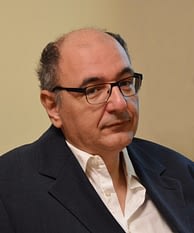Time is already running: Five ESMERA experiments are already in the second phase of their development processes and will finish the project at the end of year. These experiments have started developing robotics solutions in the summer of 2018 and have been accompanied, mentored and supported within ESMERA ever since. One of these almost finished experiments is Minotaur-R, an autonomous robotic system capable of detecting, picking and placing high radioactive Magnox springs. The ESMERA team talked to Makis Pachos from iKnowHow S.A. in Athens, who is part of the team developing Minotaur-R.
For watching the full interview on YouTube, use this link.
 First of all, congratulations. Minotaur-R is one of the experiments already in the second phase, working on the final business plans and the Go-to-Market-Strategy. So, would you in general say that the development is going well?
First of all, congratulations. Minotaur-R is one of the experiments already in the second phase, working on the final business plans and the Go-to-Market-Strategy. So, would you in general say that the development is going well?
Actually, yes. We have already achieved all the technical milestones. And we are in the process of assembling the final hardware now. There have been some significant challenges during the process, especially trying to keep the overall costs for the solution low. But now, the product is almost complete.
What is Minotaur-R about, what is the challenge you would like to solve?
It is a nuclear waste sorting challenge. Our robot identifies and picks highly radioactive Magnox springs, which are scattered among other radioactive nuclear debris of low or medium radioactivity.
Have you been able to test Minotaur-R in realistic environments?
To test it in real-life environments has not been in the scope of the challenge, of course. But in Phase II we have followed the challenge providers´ instructions to come as close to the real life environment as possible. And our new system is double the size and can cope with a much more challenging type of debris.
We had to rebuild our AI based vision system, which now works independent on lighting. And it can detect springs with down to only 20% of the spring not covered by the debris. It is a totally new system in Phase II.
That sounds good. ESMERA has already started in 2018. What made you apply for the project in the first place?
We are always looking for new challenges and ways to apply our technologies. We were already active in the area of sorting, picking and vision, so this was an opportunity to apply our expertise in the field and the market.
ESMERA is a Horizon 2020 project, what would you consider advantages and disadvantages to be part in such a project?
If you are a Start-Up, go for it! We had very good support from our mentors and we succeeded in our goals. Inside an EU project you get the means to fulfil your vision, get help and support from mentors and access to new fields, new organizations and people, which is always relevant and interesting.
You need to work within the framework of the program and there is a bit of bureaucracy involved, but you go through a learning curve and the competence centers help you, so that is just fine.
 We are already almost done. The second phase ends in December. What are your expectations for Minotaur-R after the ESMERA project will have ended?
We are already almost done. The second phase ends in December. What are your expectations for Minotaur-R after the ESMERA project will have ended?
Inside the project we have developed streams of technologies. And we intend to apply them to the waste sorting sector in general, not only the nuclear waste sector. Our deep learning AI vision system is a breakthrough in itself. And we have a green application already in mind. So we have a lot of plans.
How did you come up with the name Minotaur-R in the first place?
Originally, the Minotaur is from the Greek mythology. But Minotaur-R is actually an acronym standing for “Magnox Springs Sorting with Autonomous Robot in Radioactive Environments”. It is a catching name and makes sense from the marketing perspective.
Due to Covid-19, the whole 2020 somehow did not go according to plan. Did it have an impact on your development and progress, as well?
Initially we had some setbacks, mostly when we needed to order hardware. So we split our development and did the software first, since we could do it from home. This is why we are now in the final development phase.
Thank you very much for the interview and good luck with Minotaur-R also after the ESMERA project.
